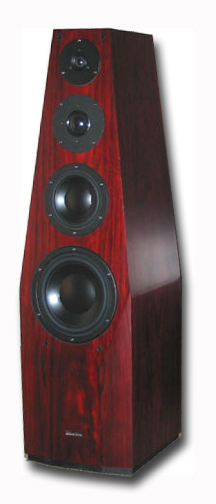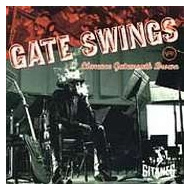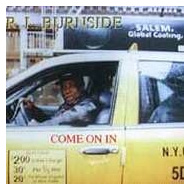You are reading the older HTML site
Positive Feedback ISSUE
12march/april 2004
silverline audio
Sonata III loudspeakers
as reviewed by Francisco Duran

FRANCISCO DURAN'S SYSTEM: LOUDSPEAKERS ELECTRONICS SOURCE CABLES ACCESSORIES
|
Reviewing a pair of Silverline speakers is like going out on a date with Jennifer Lopez—many have gone before me, but like those gentleman, I had a really good time. The Silverline Sonata IIIs are a further development of the Sonata IIs. The most obvious changes are to the cabinet, which is now more in line with those of the Sonata’s siblings, the Sonatina and the Bolero. With its multi-faceted angles and its sloping front and sides (to reduce standing waves), the new cabinet makes a very impressive visual statement, especially when you factor in the beautiful finish.
Outward appearance is not the only change to the Sonata III—most of the drivers have been changed, and the crossover got a makeover. The III features a new 1.25-inch soft dome Dynaudio tweeter, and the bass and midbass drivers are new Dynaudio models, 9.5- and 7-inch respectively. The only driver to escape the sickle was the midrange driver. The same (excellent) two-inch dome from LPG is still used. Frequency response is from 25 to 20,000 Hz, with a sensitivity of 93 dB and a nominal impedance of 8 ohms. The Art Audio Carissa amplifier, with its 16 watts, proved these specs to be true by driving these speakers with one hand tied behind its back.
The review samples were a beautiful piano black. The Silverline badge on the bottom front has a few coats of clear lacquer. If you run your fingers across it, the letters don’t stick out, and this little touch adds greatly to the speakers’ elegant appearance. For the same price, the Sonatas can be ordered in burled briarwood or rosewood. The grill covers are substantial, as are the spikes, of which there are three for each speaker. They are tall enough to pierce even the shaggiest shag carpet. My den floor slopes from left to right as I face my system (don’t ask), but this did not present a problem. The Sonatas proved easy to set up, even for one person. Once their optimal placement had been determined, it was easy to tilt them with one hand to install the spikes, despite their 110 pounds.
One thing that bothered me was the recessed speaker binding posts on the bottom rear. They were not more difficult to use than other recessed speaker binding posts, but I can’t understand why designers choose to recess the posts, especially if the speakers are rear ported. Since rear-ported designs aren’t usually placed close to the back wall, there should be ample room to hook up speaker cables without the extra difficulty of having the posts recessed. The posts are also pretty wide, so if you have small spades, be prepared to stick one leg through the center hole. Fortunately, my Analysis Plus speaker cables have wide spades. (Okay, I admit that my Spendors have flush-mounted binding posts, and have me spoiled.)
I drove the Sonatas with my usual assortment of tube amps plus one more. The Margules U280SC, with its 30-watt triode (60-watt ultralinear) option and four KT90 power tubes, had no problems driving these speakers, and made for quite a good match. The Canary CA-301MkII was another good match. It had the tightest grip on dynamics, a very sweet top end, and a very natural midrange. The Sonatas brought out the sonic subtleties that distinguished one amp from another with ease. My Monarchy SM-70 was a surprise. At first I thought that it wouldn’t be a good match with the Sonatas, but it did quite well. This sweet solid state amp is rated at 25 watts per channel and is a class A design. The high impedance of the SM-70 gave me plenty of volume when mated with my Canary CA-601 Mk.III preamp, and the combo pumped out the music. The Monarchy’s fast pace and solid dynamics brought out detail and transparency and tracked dynamics very well.
The Sonatas were placed very near to where my Spendors reside. In my 20 by 12-foot room, which contains furniture, gear, and many other things, there is not a lot of room for placement flexibility, but I found a sweet spot after some maneuvering. It was satisfying to have a pair of full-range speakers in my system—25 Hz is a lot more bass than the Spendor 2/3s put out, and while the Spendors have many good qualities, speakers that go down to 25Hz quickly reveal the limitations of small monitors. The Sonatas have honest-to-goodness low bass. There was no need to squeeze more low-end response by changing cables or repositioning the speakers.
 The Sonatas brought a fresh
listening experience to favorite discs like Gatemouth Brown’s Gate Swings,
one that I rarely experience with my bass-challenged Spendors. The
soundstage blossomed, and the bass blended with the upper ranges with ease.
Steve Rodby’s acoustic bass on Pat Metheney’s Secret Story had a nice
blend of texture, fullness, and the hollow body sound of that great
instrument. With the Sonatas, listening to the Jayhawks’ CD Hollywood
Town Hall was great fun. Mark Perlman’s electric bass and Ken
Callahan’s drumming popped along quite nicely. The Sonatas did especially
well with bass blockbusters such as reggae and large orchestral works. The
Sonatas never reproduced bass frequencies in the overly tight manner that I
hear with some full-range speakers, which skew the timbre of real bass
instruments, acoustic or electric. Alan Yun designed these speakers to
reproduce realistic bass instead of following audiophile fashion.
The Sonatas brought a fresh
listening experience to favorite discs like Gatemouth Brown’s Gate Swings,
one that I rarely experience with my bass-challenged Spendors. The
soundstage blossomed, and the bass blended with the upper ranges with ease.
Steve Rodby’s acoustic bass on Pat Metheney’s Secret Story had a nice
blend of texture, fullness, and the hollow body sound of that great
instrument. With the Sonatas, listening to the Jayhawks’ CD Hollywood
Town Hall was great fun. Mark Perlman’s electric bass and Ken
Callahan’s drumming popped along quite nicely. The Sonatas did especially
well with bass blockbusters such as reggae and large orchestral works. The
Sonatas never reproduced bass frequencies in the overly tight manner that I
hear with some full-range speakers, which skew the timbre of real bass
instruments, acoustic or electric. Alan Yun designed these speakers to
reproduce realistic bass instead of following audiophile fashion.
The new tweeter for the Sonata III is said to be more extended and detailed, and I found it to be just that. You can also throw in words like "grainless," "clear," and "airy" to describe it, not to mention "revealing." Two pair of Kimber Hero interconnects were in my system when the Sonatas entered the picture. With these, the sound had a bright character in the treble and an added chalkiness. Out went the Heros and in went one pair of Analysis Plus Solo Crystal and a pair of Kimber’s more upscale Silver Streak, and the nasty sound disappeared. The Heros also didn’t work well with the Opera Audio LP-1.0 turntable. Switching to either the Analysis Plus or the Silver Streak again did the trick. Matching this thoroughbred of a speaker to the proper cables took a little trial and error, but in the end, I found an acceptable match. Brass and strings on good recordings were floating and shimmering. On not-so-good recordings, the speakers quickly showed where the recording went wrong, but such is high-quality gear.
Dipping down in the range, the midrange driver lived up to its reputation. The 2-inch LPG driver was very open and transparent. Timbre and tone were spot on. The Jayhawks CD that I mentioned earlier was a good example of this, as was Flora Purim on Speak No Evil, Sonny Boy Williamson on Keep it to Ourselves, and Etta James on a number of her CDs. Vocals flowed naturally, but I had to really focus on the midrange to even notice this. Most of the time, the mids blended so well into the music that it was easy to get carried away.
 The Sonata IIIs amply filled
my 12 x 20 foot room, with sound to spare. The quality of the soundstage and
imaging depended upon the wire used. The speakers gave a very clear window
onto the differences between the JPS Superconductor Twos and the Analysis
Plus Solo Crystal cables. Listening to R.L. Burnside’s CD, Come On In,
the title track revealed comments and yelling from the audience, with a
believable depth and fullness that was much harder to hear with my usual
speakers. The Sonatas also did a great job of disappearing. On the Doc
Watson CD, Songs From Home, it was interesting to hear Doc and his
guitar emerging from the middle of the soundstage, in the air rather than
hung from the left or right speaker.
The Sonata IIIs amply filled
my 12 x 20 foot room, with sound to spare. The quality of the soundstage and
imaging depended upon the wire used. The speakers gave a very clear window
onto the differences between the JPS Superconductor Twos and the Analysis
Plus Solo Crystal cables. Listening to R.L. Burnside’s CD, Come On In,
the title track revealed comments and yelling from the audience, with a
believable depth and fullness that was much harder to hear with my usual
speakers. The Sonatas also did a great job of disappearing. On the Doc
Watson CD, Songs From Home, it was interesting to hear Doc and his
guitar emerging from the middle of the soundstage, in the air rather than
hung from the left or right speaker.
The power and weight of the Royal Philharmonic Orchestra doing Rachmanioff’s Symphony No. 2 on Angel or the London Symphony Orchestra doing Respighi’s Pines of Rome (also on Angel but at 45 RPM), was very evident. The Opera turntable took me back quite a few years. These LP gems have been gathering dust for far too long! The Sonatas easily demonstrated the improved staging of LP over CD. These large, full-range floorstanders danced lightly on their feet and got out of their own way like Jackie Gleason. The music never slowed or dragged. The forward flow of the musical beat sounded especially fine on ska and reggae music. To get all of this pace and rhythm, I had to find the right spot in the room to let the speakers sing—too close to the rear wall and the bass became a bit too slowed down on Caribbean music. I pulled them out about three feet at first, then four. This was acceptable, but I had to be careful not to sit too close to them. A room wider than 12 feet might have been preferable, but with a little care they snapped into focus.
The strongest suit of these speakers is their tonal balance. In the back of my mind I kept thinking that with eight drivers, this shouldn’t be the case, but the music was always coherent and whole. Although the treble was extended, the midrange focused, and the bass strong, no part of the frequency spectrum was ever overbearing. After I was able find the right position in the room for the bass, these speakers spoke with one voice.
After my listening time with the big Silverlines, I reluctantly put my Spendors back into my system. The first shock was that there seemed to be no bass. The second was that they didn’t sound as clean. They were not only warmer but somewhat fuzzier. This wouldn’t do. After repositioning and switching back to bi-wiring, the good old 2/3s slowly came back into focus. They have plenty of detail, and enough bass and dynamics to satisfy me, but compared to the Sonatas, they go about the reproduction of music in a nonchalant, laid-back manner.
The Silverline Sonata III speakers have a fine balance of virtues. They have a solid tonal balance. They are sufficiently detailed and transparent to rival speakers that sell for much more than their price. Their bass performance is realistic, slightly rich and full. They give more than their share of musicality at a price that, while not slim, is fair considering what you get in build and parts quality. They mated well with the four amps that I tried with them, each of differing design. I could easily live many happy years with the Sonata IIIs, after all the dating is over! Francisco Duran
Sonata III
Retail: $7200 pair
Silverline Audio
web address:
www.silverlineaudio.com
TEL:
925. 825. 3682
